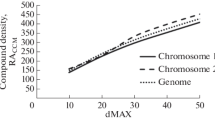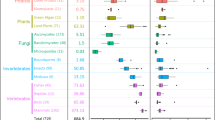Abstract
Simple sequence repeats (SSRs) or microsatellites are the repetitive nucleotide sequences of motifs of length 1–6 bp. They are scattered throughout the genomes of all the known organisms ranging from viruses to eukaryotes. Microsatellites undergo mutations in the form of insertions and deletions (INDELS) of their repeat units with some bias towards insertions that lead to microsatellite tract expansion. Although prokaryotic genomes derive some plasticity due to microsatellite mutations they have in-built mechanisms to arrest undue expansions of microsatellites and one such mechanism is constituted by post-replicative DNA repair enzymes MutL, MutH and MutS. The mycobacterial genomes lack these enzymes and as a null hypothesis one could expect these genomes to harbour many long tracts. It is therefore interesting to analyse the mycobacterial genomes for distribution and abundance of microsatellites tracts and to look for potentially polymorphic microsatellites. Available mycobacterial genomes, Mycobacterium avium, M. leprae, M. bovis and the two strains of M. tuberculosis (CDC1551 and H37Rv) were analysed for frequencies and abundance of SSRs. Our analysis revealed that the SSRs are distributed throughout the mycobacterial genomes at an average of 220–230 SSR tracts per kb. All the mycobacterial genomes contain few regions that are conspicuously denser or poorer in microsatellites compared to their expected genome averages. The genomes distinctly show scarcity of long microsatellites despite the absence of a post-replicative DNA repair system. Such severe scarcity of long microsatellites could arise as a result of strong selection pressures operating against long and unstable sequences although influence of GC-content and role of point mutations in arresting microsatellite expansions can not be ruled out. Nonetheless, the long tracts occasionally found in coding as well as non-coding regions may account for limited genome plasticity in these genomes.
Similar content being viewed by others
Abbreviations
- INDELS:
-
Insertions and deletions
- ML:
-
M.leprae
- MA:
-
M. avium
- MB:
-
M. bovis
- MTC:
-
M. tuberculosis
- PPM:
-
potential polymorphic microsatellite
- SSRs:
-
simple sequence repeates
References
Balloux F, Ecoffey E, Fumagalli L, Goudet J, Wyttenbach A and Hausser J 1998 Microsatellite conservation, polymorphism, and GC content in shrews of the genus Sorex (Insectivora, Mammalia); Mol. Biol. Evol. 15 473–475
Brinkmann B, Klintschar M, Neuhuber F, Huhne J and Rolf B 1998 Mutation rate in human microsatellites: influence of the structure and length of the tandem repeat; Am. J. Hum. Genet. 62 1408–1415
Burge C, Campbell A M and Karlin S 1992 Over-and underrepresentation of short oligonucleotides in DNA sequences; Proc. Natl. Acad. Sci. USA 89 1358–1362
Cole S T, Brosch R, Parkhill J, Garnier T, Churcher C, Harris D, Gordon S V, Eiglmeier K et al 1998 Deciphering the biology of Mycobacterium tuberculosis from the complete genome sequence; Nature (London) 393 537–544
Cole S T, Eiglmeier K, Parkhill J, James K D, Thomson N R, Wheeler P R, Honore N, Garnier T et al 2001 Massive gene decay in the leprosy bacillus; Nature (London) 409 1007–1011
Cosma C L, Sherman D R and Ramakrishnan L 2003 The secret lives of the pathogenic mycobacteria; Annu. Rev. Microbiol. 57 641–676
Ellegren H 2004 Microsatellites: simple sequences with complex evolution; Nature Rev. Genet. 5 435–445
Field D and Wills C 1998 Abundant microsatellite polymorphism in Saccharomyces cerevisiae, and the different distributions of microsatellites in eight prokaryotes and S. cerevisiae, result from strong mutation pressures and a variety of selective forces; Proc. Natl. Acad. Sci. USA 95 1647–1652
Fleischmann et al 2002 Whole genome comparison of Mycobacterium tuberculosis clinical and laboratory strains; J. Bacteriol. 184 5479–5490
Garnier T, Eiglmeier K, Camus J C, Medina N, Mansoor H, Pryor M, Duthoy S, Grondin S et al 2003 The complete genome sequence of Mycobacterium bovis; Proc. Natl. Acad. Sci. USA 100 7877–7882.
Glenn T C, Stephan W, Dessauer H C and Braun M J 1996 Allelic diversity in alligator microsatellite loci is negatively correlated with GC content of flanking sequences and evolutionary conservation of PCR amplifiability; Mol. Biol. Evol. 13 1151–1154
Groathouse N A, Rivoire B, Kim H, Lee H, Cho S N, Brennan P J and Vissa V D 2004 Multiple polymorphic loci for molecular typing of strains of Mycobacterium leprae; J. Clin. Microbiol. 42 1666–1672
Gur-Arie R, Cohen C J, Eitan Y, Shelef L, Hallerman E M and Kashi Y 2000 Simple sequence repeats in Escherichia coli: abundance, distribution, composition, and polymorphism; Genome Res. 10 62–71
Heller M, van Santen V and Kieff E 1982 Simple repeat sequence in Epstein-Barr virus DNA is transcribed in latent and productive infections; J. Virol. 44 311–320
Hermans P W M, van Soolingen D, Bik M, de Haas P E W, Dale J W and van Embden J D A 1991 The insertion element IS987 from Mycobacterium bovis BCG is located in a hot-spot integration region for insertion elements in M. tuberculosis complex strains; Infect. Immun. 59 2695–2705
Hinrichs W, Kisker C, Duvel M, Muller A, Tovar K, Hillen W and Saenger W 1994 Structure of the Tet repressor-tetracycline complex and regulation of antibiotic resistance; Science 264 418–420
Hood D W, Deadman M E, Jennings M P, Bisercic M, Fleischmann R D, Venter J C and Moxon E R 1996 DNA repeats identify novel virulence genes in Haemophilus influenzae; Proc. Natl. Acad. Sci. USA 93 11121–11125
Jackson A L, Chen R and Loeb L A 1998 Induction of microsatellite instability by oxidative DNA damage; Proc. Natl. Acad. Sci. USA 95 12468–12473
Kamebeek J L S, Kolk A, van Agterveld M, van Soolingen D, Kuijper S, Bunschoten A, Molhuizen H, Shaw R, Goyal M and van Embden J D A 1997 Simultaneous detection and strain differentiation of Mycobacterium tuberculosis for diagnosis and epidemiologyp; J. Clin. Microbiol 35 907–914
Karlin S, Mrazek J and Campbell A M 1997 Compositional biases of bacterial genomes and evolutionary implications; J. Bacteriol. 179 3899–3913
Kisker C, Hinrichs W, Tovar K, Hillen W and Saenger W 1995 The complex formed between Tet repressor and tetracycline-Mg2+ reveals mechanism of antibiotic resistance; J. Mol. Biol. 247 260–280
Kruglyak S, Durrett R T, Schug M D and Aquadro C F 1998 Equilibrium distributions of microsatellite repeat length resulting from a balance between slippage events and point mutations; Proc. Natl. Acad. Sci. USA 95 10774–10778
Levinson G and Gutman G A 1987 Slipped-strand mispairing: a major mechanism for DNA sequence evolution; Mol. Biol. Evol. 4 203–221
Li L, Bannantine J P, Zhang Q, Amonsin A, May B J, Alt D, Banerji N, Kanjilal S and Kapur V 2005 The complete genome sequence of Mycobacterium avium subspecies paratuberculosis; Proc. Natl. Acad. Sci. USA 102 12344–12349
Moxon E R, Rainey P B, Nowak M A and Lenski R E 1994 Adaptive evolution of highly mutable loci in pathogenic bacteria; Curr. Biol. 4 24–33
Murphy G L, Connell T D, Barritt D S, Koomey M and Cannon J G 1989 Phase variation of gonococcal protein II: regulation of gene expression by slipped-strand mispairing of a repetitive DNA sequence; Cell 56 539–547
Nauta M J and Weissing F J 1996 Constraints on allele size at microsatellite loci: implications for genetic differentiation; Genetics 143 1021–1032
Press W H, Flannery B P, Teukolsky S A and Vetterling W T 1992 Numerical recipes in C (Cambridge: Cambridge University Press)
Rocha E P, Matic I and Taddei F 2002 Over-representation of repeats in stress response genes: a strategy to increase versatility under stressful conditions?; Nucleic Acids Res. 30 1886–1894
Schlotterer C 2000 Evolutionary dynamics of microsatellite DNA; Chromosoma 109 365–371
Schlotterer C and Tautz D 1992 Slippage synthesis of simple sequence DNA; Nucleic Acids Res. 20 211–215
Seraphin B 1992 The HIT protein family: a new family of proteins present in prokaryotes, yeast and mammals; DNA Seq. 3 177–179
Shinde D, Lai Y, Sun F and Arnheim N 2003 Taq DNA polymerase slippage mutation rates measured by PCR and quasi-likelihood analysis: (CA/GT)n and (A/T)n microsatellites; Nucleic Acids Res. 31 974–980
Springer B, Sander P, Sedlacek L, Hardt W, Mizrahi V, Schär P and Böttger E C 2004 Lack of mismatch correction facilitates genome evolution in mycobacteria; Mol. Microbiol. 53 1601–1609
Sreenu V B, Alevoor V, Nagaraju J and Nagarajaram H A 2003 MICdb: database of prokaryotic microsatellites; Nucleic Acids Res. 31 106–168
Sreenu V B, Kumar P, Nagaraju J and Nagarajaram H A 2006 Microsatellite polymorphism across the M. tuberculosis and M. bovis genomes: implications on genome evolution and plasticity; BMC Genomics 7 78
Tomb J F, White O, Kerlavage A R, Clayton R A, Sutton G G, Fleischmann R D, Ketchum K A, Klenk H P, Gill S et al 1997 The complete genome sequence of the gastric pathogen Helicobacter pylori; Nature (London) 388 539–547
van Belkum A, Scherer S, van Alphen L and Verbrugh H 1998 Short-sequence DNA repeats in prokaryotic genomes; Microbiol. Mol. Biol. Rev. 62 275–293
van Ham S M, van Alphen L, Mooi F R and van Putten J P 1993 Phase variation of H. influenzae fimbriae: transcriptional control of two divergent genes through a variable combined promoter region; Cell 73 1187–1196
van Soolingen D, de Haas P E W, Hermans P W M, Groenen P M A and van Embden J D A 1993 Comparison of various repetitive DNA elements as genetic markers for strain differentiation and epidemiology of Mycobacterium tuberculosis; J. Clin. Microbiol. 31 1987–1995
Author information
Authors and Affiliations
Corresponding author
Additional information
Supplementary Data pertaining to this article is available on the Journal of Biosciences Website at http://www.ias.ac.in/jbiosci/jan2007/pp3-15-suppl.pdf
Rights and permissions
About this article
Cite this article
Sreenu, V.B., Kumar, P., Nagaraju, J. et al. Simple sequence repeats in mycobacterial genomes. J Biosci 32, 3–15 (2007). https://doi.org/10.1007/s12038-007-0002-7
Published:
Issue Date:
DOI: https://doi.org/10.1007/s12038-007-0002-7




